Habitat Suitability Analysis and Future Distribution Prediction of Giant Panda (Ailuropoda melanoleuca) in the Qinling Mountains, China
Abstract
:1. Introduction
2. Materials and Methods
2.1. Overview of the Research Area
2.2. Research Methods
2.2.1. Calculation of Suitable Habitat Index for Giant Pandas
- (1)
- Species distribution data
- (2)
- Environmental factors and pretreatment
- (3)
- MaxEnt model analysis
- (4)
- Suitable habitat classification criteria
2.2.2. Methods of Ecosystem Service Evaluation
- (1)
- Hydrological regulation
- (2)
- Soil conservation
- (3)
- Net primary productivity
- (4)
- Calculation of total ecosystem services
- (5)
- Data sources for ecosystem services mapping
2.2.3. Calculation of Relationship between Suitable Habitat Index and Ecosystem Services of Giant Panda
3. Results
3.1. Suitable Habitat Index for Giant Pandas
3.2. Spatial Distribution Pattern of Ecosystem Services
3.3. Relationship between Suitable Habitat Index and Ecosystem Services of Giant Panda
3.4. Analysis of Gaps in Wild Giant Panda Habitat Protection
3.5. Distribution and Change of Potential Suitable Habitat of Giant Panda in the Qinling Mountains using Future Climate Scenarios
3.6. Centroid Migration and Influencing Factors of Giant Panda in the Qinling Mountains in Climate Change
4. Discussion
4.1. Analysis of the Correlation between Suitable Habitat and Ecosystem Services of Giant Panda
4.2. Impact of Human Activities on the Potential Geographical Distribution of Giant Pandas
4.3. Response of Giant Panda Habitat to Climate Change
4.4. Conservation Status of Giant Panda Habitat in the Qinling Mountains
5. Conclusions
Author Contributions
Funding
Institutional Review Board Statement
Data Availability Statement
Conflicts of Interest
References
- Butchart, S.H.M.; Walpole, M.; Collen, B.; Van Strien, A.; Scharlemann, J.P.W.; Almond, R.E.A.; Baillie, J.E.M.; Bomhard, B.; Brown, C.; Bruno, J.; et al. Global Biodiversity: Indicators of Recent Declines. Science 2010, 328, 1164–1168. [Google Scholar] [CrossRef] [PubMed]
- Urban, M.C. Accelerating Extinction Risk from Climate Change. Science 2015, 348, 571–573. [Google Scholar] [CrossRef] [PubMed]
- Pauli, H.; Gottfried, M.; Reiter, K.; Klettner, C.; Grabherr, G. Signals of Range Expansions and Contractions of Vascular Plants in the High Alps: Observations (1994–2004) at the GLORIA * Master Site Schrankogel, Tyrol, Austria. Glob. Chang. Biol. 2007, 13, 147–156. [Google Scholar] [CrossRef]
- Bellard, C.; Bertelsmeier, C.; Leadley, P.; Thuiller, W.; Courchamp, F. Impacts of Climate Change on the Future of Biodiversity. Ecol. Lett. 2012, 15, 365–377. [Google Scholar] [CrossRef] [PubMed]
- Wei, W.; Swaisgood, R.R.; Pilfold, N.W.; Owen, M.A.; Dai, Q.; Wei, F.W.; Han, H.; Yang, Z.; Yang, X.Y.; Gu, X.D.; et al. Assessing the Effectiveness of China’s Panda Protection System. Curr. Biol. 2020, 30, 1280–1286.e2. [Google Scholar] [CrossRef] [PubMed]
- Wei, F.W.; Swaisgood, R.; Hu, Y.B.; Nie, Y.; Yan, L.; Zhang, Z.J.; Qi, D.W.; Zhu, L.F. Progress in the Ecology and Conservation of Giant Pandas. Conserv. Biol. 2015, 29, 1497–1507. [Google Scholar] [CrossRef] [PubMed]
- Gao, J.X. Exploring the Delineation and Supervision of Ecological Protection Redlines in China. Biodivers. Sci. 2015, 23, 705–707. [Google Scholar] [CrossRef]
- Huang, Q.Y.; Fei, Y.X.; Yang, H.B.; Gu, X.D.; Songer, M. Giant Panda National Park, a Step towards Streamlining Protected Areas and Cohesive Conservation Management in China. Glob. Ecol. Conserv. 2020, 22, e00947. [Google Scholar] [CrossRef]
- Laforest-Lapointe, I.; Paquette, A.; Messier, C.; Kembel, S.W. Leaf Bacterial Diversity Mediates Plant Diversity and Ecosystem Function Relationships. Nature 2017, 546, 145–147. [Google Scholar] [CrossRef]
- Qin, A.L.; Liu, B.; Guo, Q.S.; Bussmann, R.W.; Ma, F.Q.; Jian, Z.J.; Xu, G.X.; Pei, S.X. Maxent Modeling for Predicting Impacts of Climate Change on the Potential Distribution of Thuja Sutchuenensis Franch., an Extremely Endangered Conifer from Southwestern China. Glob. Ecol. Conserv. 2017, 10, 139–146. [Google Scholar] [CrossRef]
- Chan, K.M.A.; Hoshizaki, L.; Klinkenberg, B. Ecosystem Services in Conservation Planning: Targeted Benefits vs. Co-Benefits or Costs? PLoS ONE 2011, 6, e24378. [Google Scholar] [CrossRef] [PubMed]
- Balvanera, P.; Daily, G.C.; Ehrlich, P.R.; Ricketts, T.H.; Bailey, S.-A.; Kark, S.; Kremen, C.; Pereira, H. Conserving Biodiversity and Ecosystem Services. Science 2001, 291, 2047. [Google Scholar] [CrossRef] [PubMed]
- Haddad, N.M.; Brudvig, L.A.; Clobert, J.; Davies, K.F.; Gonzalez, A.; Holt, R.D.; Lovejoy, T.E.; Sexton, J.O.; Austin, M.P.; Collins, C.D.; et al. Habitat Fragmentation and Its Lasting Impact on Earth’s Ecosystems. Sci. Adv. 2015, 1, e1500052. [Google Scholar] [CrossRef] [PubMed]
- Thomsen, M.S.; Garcia, C.; Bolam, S.G.; Parker, R.; Godbold, J.A.; Solan, M. Consequences of Biodiversity Loss Diverge from Expectation Due to Post-Extinction Compensatory Responses. Sci. Rep. 2017, 7, 43695. [Google Scholar] [CrossRef] [PubMed]
- Crist, E.; Mora, C.; Engelman, R. The Interaction of Human Population, Food Production, and Biodiversity Protection. Science 2017, 356, 260–264. [Google Scholar] [CrossRef] [PubMed]
- Shen, Y.; Yu, S.X.; Lian, J.Y.; Shen, H.; Cao, H.L.; Lu, H.P.; Ye, W.H. Tree Aboveground Carbon Storage Correlates with Environmental Gradients and Functional Diversity in a Tropical Forest. Sci. Rep. 2016, 6, 25304. [Google Scholar] [CrossRef] [PubMed]
- Huang, Y.Y.; Chen, Y.X.; Castro-Izaguirre, N.; Baruffol, M.; Brezzi, M.; Lang, A.; Li, Y.; Härdtle, W.; Von Oheimb, G.; Yang, X.F.; et al. Impacts of Species Richness on Productivity in a Large-Scale Subtropical Forest Experiment. Science 2018, 362, 80–83. [Google Scholar] [CrossRef] [PubMed]
- Hector, A.; Bagchi, R. Biodiversity and Ecosystem Multifunctionality. Nature 2007, 448, 188–190. [Google Scholar] [CrossRef] [PubMed]
- Wagg, C.; Bender, S.F.; Widmer, F.; Van Der Heijden, M.G.A. Soil Biodiversity and Soil Community Composition Determine Ecosystem Multifunctionality. Proc. Natl. Acad. Sci. USA 2014, 111, 5266–5270. [Google Scholar] [CrossRef]
- Balvanera, P.; Siddique, I.; Dee, L.; Paquette, A.; Isbell, F.; Gonzalez, A.; Byrnes, J.; O’Connor, M.I.; Hungate, B.A.; Griffin, J.N. Linking Biodiversity and Ecosystem Services: Current Uncertainties and the Necessary Next Steps. BioScience 2014, 64, 49–57. [Google Scholar] [CrossRef]
- Anderson, B.J.; Armsworth, P.R.; Eigenbrod, F.; Thomas, C.D.; Gillings, S.; Heinemeyer, A.; Roy, D.B.; Gaston, K.J. Spatial Covariance between Biodiversity and Other Ecosystem Service Priorities. J. Appl. Ecol. 2009, 46, 888–896. [Google Scholar] [CrossRef]
- Fang, Y.Q.; Zhang, X.H.; Wei, H.Y.; Wang, D.J.; Chen, R.D.; Wang, L.K.; Gu, W. Predicting the Invasive Trend of Exotic Plants in China Based on the Ensemble Model under Climate Change: A Case for Three Invasive Plants of Asteraceae. Sci. Total Environ. 2021, 756, 143841. [Google Scholar] [CrossRef] [PubMed]
- Zhang, X.Q.; Li, G.Q.; Du, S. Simulating the Potential Distribution of Elaeagnus Angustifolia L. Based on Climatic Constraints in China. Ecol. Eng. 2018, 113, 27–34. [Google Scholar] [CrossRef]
- Anoop, N.R.; Babu, S.; Nagarajan, R.; Sen, S. Identifying Suitable Reintroduction Sites for the White-Rumped Vulture (Gyps bengalensis) in India’s Western Ghats Using Niche Models and Habitat Requirements. Ecol. Eng. 2020, 158, 106034. [Google Scholar] [CrossRef]
- Songer, M.; Delion, M.; Biggs, A.; Huang, Q. Modeling Impacts of Climate Change on Giant Panda Habitat. Int. J. Ecol. 2012, 2012, 108752. [Google Scholar] [CrossRef]
- Qi, Z.X.; Xu, W.H.; Xiong, X.Y.; Ouyang, Z.Y.; Zheng, H.; Gan, D.X. Assessment of potential habitat for Ursus thibetanus in the Qinling Mountains. Biodivers. Sci. 2011, 19, 343–352. [Google Scholar] [CrossRef]
- Xu, W.; Luo, C. Application of MaxEnt Model in Rhinopithecus Roxllanae Habitat Assessment in Qingling Mountains. For. Eng. 2010, 26, 23–26. [Google Scholar]
- Olson, D.M.; Dinerstein, E. The Global 200: A Representation Approach to Conserving the Earth’s Most Biologically Valuable Ecoregions. Conserv. Biol. 1998, 12, 502–515. [Google Scholar] [CrossRef]
- Hull, V.; Zhang, J.D.; Zhou, S.Q.; Huang, J.Y.; Li, R.; Liu, D.; Xu, W.H.; Huang, Y.; Ouyang, Z.Y.; Zhang, H.M.; et al. Space Use by Endangered Giant Pandas. J. Mammal. 2015, 96, 230–236. [Google Scholar] [CrossRef]
- Zhao, C.; Yue, B.S.; Ran, J.H.; Moermond, T.; Hou, N.; Yang, X.Y.; Gu, X.D. Relationship between Human Disturbance and Endangered Giant Panda Ailuropoda Melanoleuca Habitat Use in the Daxiangling Mountains. Oryx 2017, 51, 146–152. [Google Scholar] [CrossRef]
- Tang, J.; Swaisgood, R.R.; Owen, M.A.; Zhao, X.Z.; Wei, W.; Pilfold, N.W.; Wei, F.W.; Yang, X.Y.; Gu, X.D.; Yang, Z.S.; et al. Climate Change and Landscape-Use Patterns Influence Recent Past Distribution of Giant Pandas. Proc. R. Soc. B Biol. Sci. 2020, 287, 20200358. [Google Scholar] [CrossRef]
- Sun, X.; Long, Z.X.; Jia, J.B. A Multi-Scale Maxent Approach to Model Habitat Suitability for the Giant Pandas in the Qionglai Mountain, China. Glob. Ecol. Conserv. 2021, 30, e01766. [Google Scholar] [CrossRef]
- Phillips, S.J.; Anderson, R.P.; Schapire, R.E. Maximum Entropy Modeling of Species Geographic Distributions. Ecol. Model. 2006, 190, 231–259. [Google Scholar] [CrossRef]
- Qi, D.W.; Hu, Y.B.; Gu, X.D.; Li, M.; Wei, F.W. Ecological Niche Modeling of the Sympatric Giant and Red Pandas on a Mountain-Range Scale. Biodivers. Conserv. 2009, 18, 2127–2141. [Google Scholar] [CrossRef]
- Swets, J.A. Measuring the Accuracy of Diagnostic Systems. Science 1988, 240, 1285–1293. [Google Scholar] [CrossRef] [PubMed]
- Liu, C.R.; White, M.; Newell, G. Selecting Thresholds for the Prediction of Species Occurrence with Presence-only Data. J. Biogeogr. 2013, 40, 778–789. [Google Scholar] [CrossRef]
- Wu, D.; Cao, W.; Huang, L.; Huhe, T.L. Assessing Ecological Effects of Natural Forest Protection Project. J. Changjiang River Sci. Res. Inst. 2023, 40, 73–80. [Google Scholar] [CrossRef]
- Xiao, Q.; Hu, D.; Xiao, Y. Assessing Changes in Soil Conservation Ecosystem Services and Causal Factors in the Three Gorges Reservoir Region of China. J. Clean. Prod. 2017, 163, S172–S180. [Google Scholar] [CrossRef]
- Ouyang, Z.Y.; Zheng, H.; Xiao, Y.; Polasky, S.; Liu, J.G.; Xu, W.H.; Wang, Q.; Zhang, L.; Xiao, Y.; Rao, E.; et al. Improvements in Ecosystem Services from Investments in Natural Capital. Science 2016, 352, 1455–1459. [Google Scholar] [CrossRef] [PubMed]
- Zhu, W.Q.; Pan, Y.Z.; Zhang, J.S. Estimation of net primary productivity of Chinese terrestrial vegetation based on remote sensing. J. Plant Ecol. 2007, 31, 413–424. [Google Scholar] [CrossRef]
- Xie, T.; Wang, M.; Su, C.; Chen, W.P. Evaluation of the Natural Attenuation Capacity of Urban Residential Soils with Ecosystem-Service Performance Index (EPX) and Entropy-Weight Methods. Environ. Pollut. 2018, 238, 222–229. [Google Scholar] [CrossRef]
- Jopke, C.; Kreyling, J.; Maes, J.; Koellner, T. Interactions among Ecosystem Services across Europe: Bagplots and Cumulative Correlation Coefficients Reveal Synergies, Trade-Offs, and Regional Patterns. Ecol. Indic. 2015, 49, 46–52. [Google Scholar] [CrossRef]
- Zhang, Z.J.; Wei, F.W.; Li, M.; Zhang, B.W.; Liu, X.H.; Hu, J.C. Microhabitat Separation during Winter among Sympatric Giant Pandas, Red Pandas, and Tufted Deer: The Effects of Diet, Body Size, and Energy Metabolism. Can. J. Zool. 2004, 82, 1451–1458. [Google Scholar] [CrossRef]
- Du, Y.L.; Zhang, Y.; Dong, G.H.; Lou, X.D.; Kang, B. Diversity of Fargesia qinlingensis Community in QinLing Mountains. J. Northwest A F Univ. 2013, 41, 59–66. [Google Scholar] [CrossRef]
- Zhang, Z.J.; Hu, J.C. A Study on the Giant Panda’s Habitat Selection. J. Sichuan Teach. Coll. Sci. 2000, 21, 18–21. [Google Scholar] [CrossRef]
- Wei, F.W.; Zhou, A.; Hu, J.C.; Wang, W.; Yang, G. Habitat Selection by Giant Pandas in Mabian Dafenging Reserve. Acta Theriol. Sin. 1996, 16, 241–245. [Google Scholar] [CrossRef]
- Zhou, S.Q.; Zhang, H.M.; Li, D.S. Conservation and Management Strategies of Habitats Based on the Foraging Behavior of Giant Pandas. Sichuan J. Zool. 2010, 29, 340–345. [Google Scholar]
- Viña, A.; McConnell, W.J.; Yang, H.B.; Xu, Z.C.; Liu, J.G. Effects of Conservation Policy on China’s Forest Recovery. Sci. Adv. 2016, 2, e1500965. [Google Scholar] [CrossRef]
- Zhang, J.D.; Hull, V.; Ouyang, Z.Y.; Li, R.; Connor, T.; Yang, H.B.; Zhang, Z.J.; Silet, B.; Zhang, H.B.; Liu, J.G. Divergent Responses of Sympatric Species to Livestock Encroachment at Fine Spatiotemporal Scales. Biol. Conserv. 2017, 209, 119–129. [Google Scholar] [CrossRef]
- Loucks, C.J.; Lü, Z.; Dinerstein, E.; Wang, H.; Olson, D.M.; Zhu, C.Q.; Wang, D.J. Giant Pandas in a Changing Landscape. Science 2001, 294, 1465. [Google Scholar] [CrossRef]
- Qi, D.W.; Zhang, S.N.; Zhang, Z.J.; Hu, Y.B.; Yang, X.Y.; Wang, H.J.; Wei, F.W. Different Habitat Preferences of Male and Female Giant Pandas. J. Zool. 2011, 285, 205–214. [Google Scholar] [CrossRef]
- Sun, C.Q.; Zhang, Z.L.; Jin, X.L. QinLing mountains giant panda sub-population quantity and distribution. J. Shaanxi Norm. Univ. Sci. Ed. 2006, 34, 163–167. [Google Scholar]
- Huang, L.; Xing, X.C.; Li, W.W.; Zhou, Y.; Zhang, Y.Q.; Xue, C.; Ren, Y.; Kang, J.Q. Altitude Difference Might Contribute to the Genetic Divergence of Giant Panda’ Staple Food Bamboo (Fargesia spathacea Complex) Based on 14 SSR Markers. J. Syst. Evol. 2021, 59, 1051–1064. [Google Scholar] [CrossRef]
- Li, X.; Mao, F.J.; Du, H.Q.; Zhou, G.H.; Xing, L.; Liu, T.Y.; Han, N.; Liu, Y.L.; Zhu, D.E.; Zheng, J.L.; et al. Spatiotemporal Evolution and Impacts of Climate Change on Bamboo Distribution in China. J. Environ. Manag. 2019, 248, 109265. [Google Scholar] [CrossRef] [PubMed]
- Jian, J.; Jiang, H.; Jiang, Z.S.; Zhou, G.M.; Yu, S.Q.; Peng, S.L.; Liu, S.R.; Liu, S.Y.; Wang, J.X. Predicting Giant Panda Habitat with Climate Data and Calculated Habitat Suitability Index (HSI) Map: Predicting Giant Panda Habitat. Meteorol. Appl. 2014, 21, 210–217. [Google Scholar] [CrossRef]
- Xu, W.H.; Ouyang, Z.Y.; Viña, A.; Zheng, H.; Liu, J.G.; Xiao, Y. Designing a Conservation Plan for Protecting the Habitat for Giant Pandas in the Qionglai Mountain Range, China. Divers. Distrib. 2006, 12, 610–619. [Google Scholar] [CrossRef]
- Shen, G.Z.; Feng, C.Y.; Xie, Z.Q.; Ouyang, Z.Y.; Li, J.Q.; Pascal, M. Proposed Conservation Landscape for Giant Pandas in the Minshan Mountains, China. Conserv. Biol. 2008, 22, 1144–1153. [Google Scholar] [CrossRef] [PubMed]
- Fan, J.T.; Li, J.S.; Xia, R.; Hu, L.L.; Wu, X.P.; Li, G. Assessing the Impact of Climate Change on the Habitat Distribution of the Giant Panda in the Qinling Mountains of China. Ecol. Model. 2014, 274, 12–20. [Google Scholar] [CrossRef]
- Wang, F.; Zhao, Q.; McShea, W.J.; Songer, M.; Huang, Q.Y.; Zhang, X.F.; Zhou, L.G. Incorporating Biotic Interactions Reveals Potential Climate Tolerance of Giant Pandas. Conserv. Lett. 2018, 11, e12592. [Google Scholar] [CrossRef]
- Qing, J.; Yang, Z.S.; He, K.; Zhang, Z.J.; Gu, X.D.; Yang, X.Y.; Zhang, W.; Yang, B.; Qi, D.W.; Dai, Q. The Minimum Area Requirements (MAR) for Giant Panda: An Empirical Study. Sci. Rep. 2016, 6, 37715. [Google Scholar] [CrossRef]
- Yin, R.S. An Integrated Assessment of China’s Ecological Restoration Programs; Springer: Dordrecht, The Netherlands, 2009; pp. 21–38. [Google Scholar]
- Xu, W.; Viña, A.; Kong, L.Q.; Pimm, S.L.; Zhang, J.J.; Yang, W.; Xiao, Y.; Zhang, L.; Chen, X.D.; Liu, J.G.; et al. Reassessing the Conservation Status of the Giant Panda Using Remote Sensing. Nat. Ecol. Evol. 2017, 1, 1635–1638. [Google Scholar] [CrossRef] [PubMed]
- Cai, Q.; Huang, B.H.; Li, P.; Yang, Z.; Lin, Y.C.; Zhu, Y.; Cheng, H.F.; Zhang, H.F. Wildlife Activities and Migration through Ecological Corridor along Channel of Highway No.108. Shannxi For. Sci. Technol. 2019, 47, 6–9. [Google Scholar]
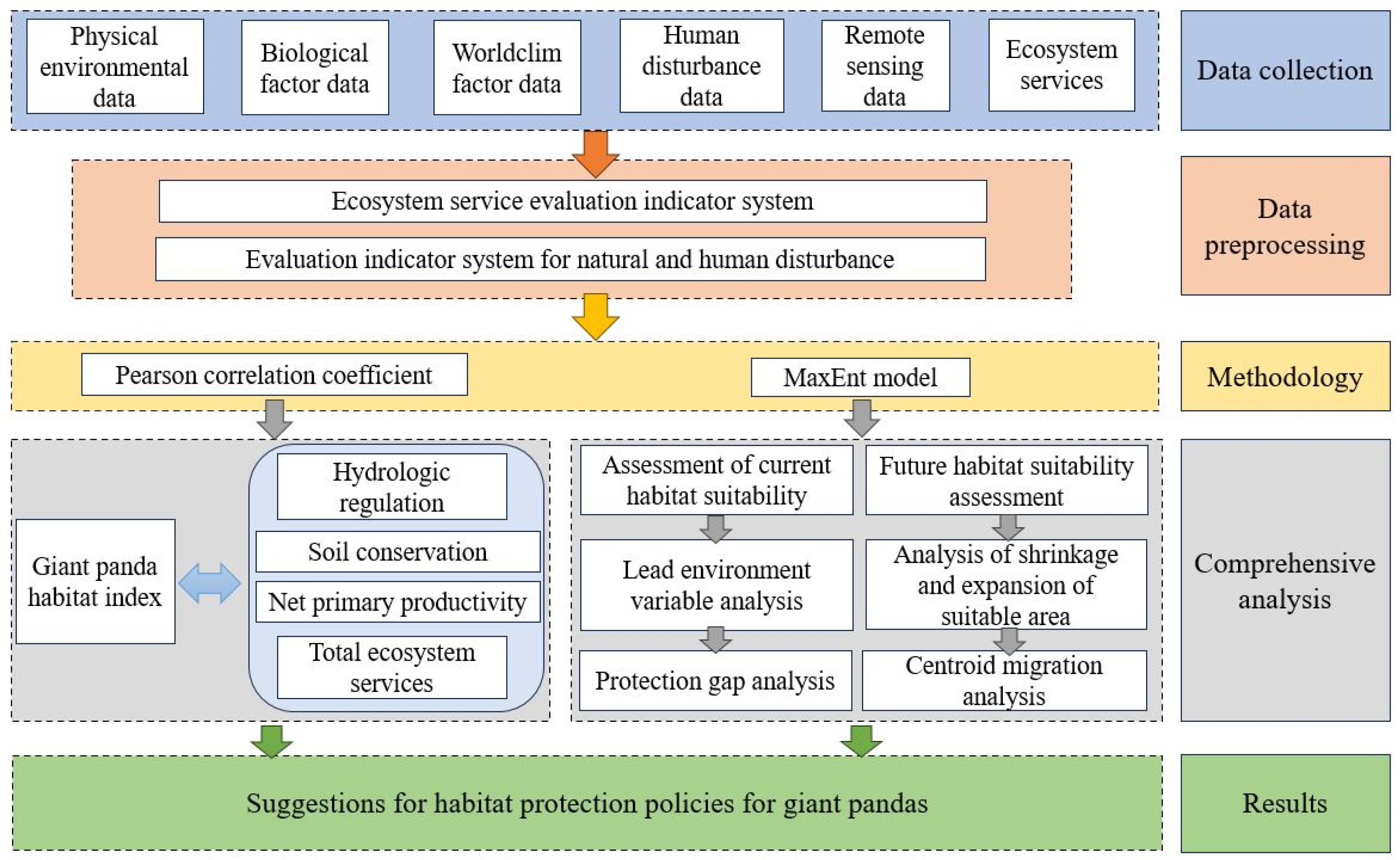
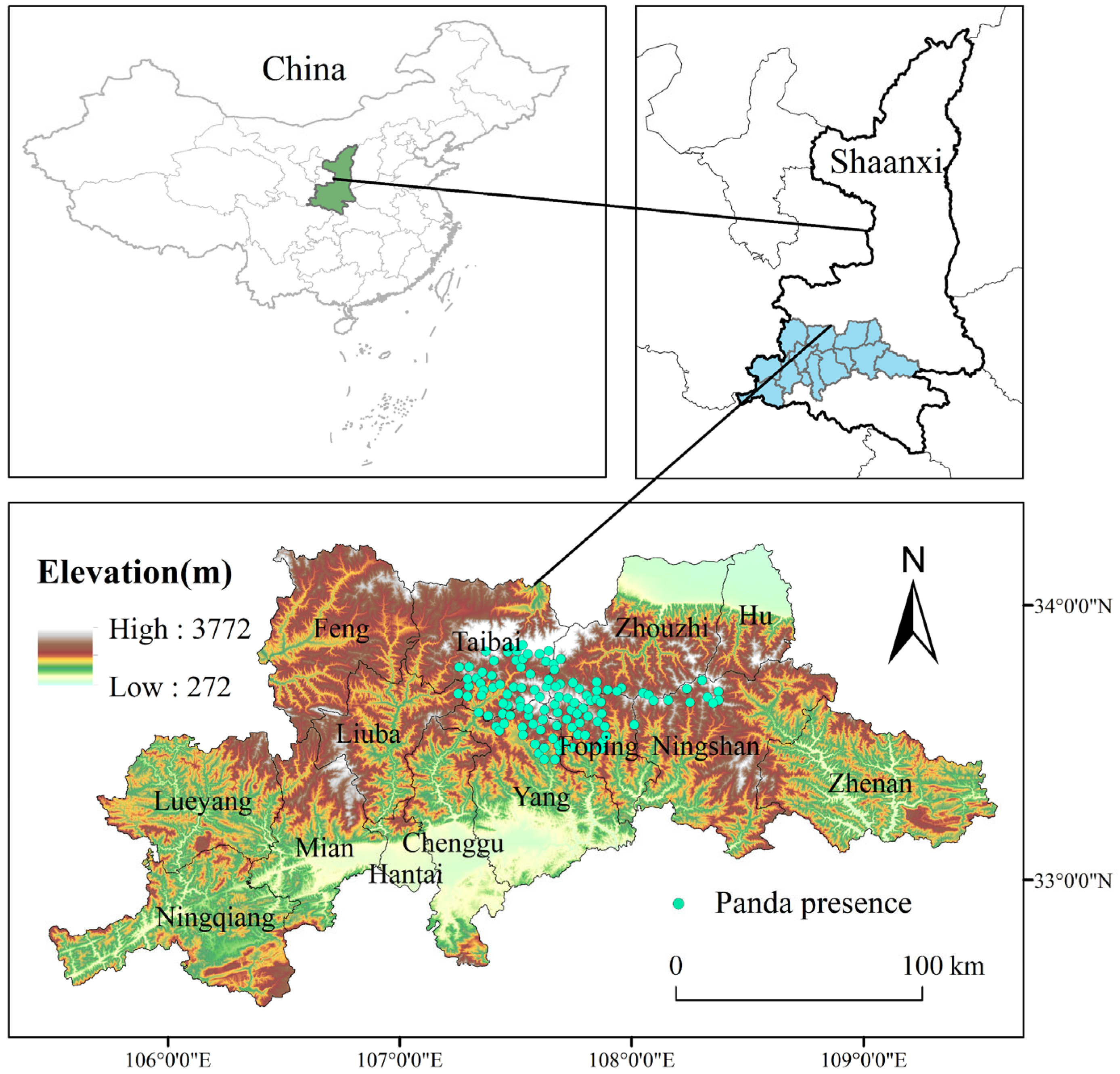
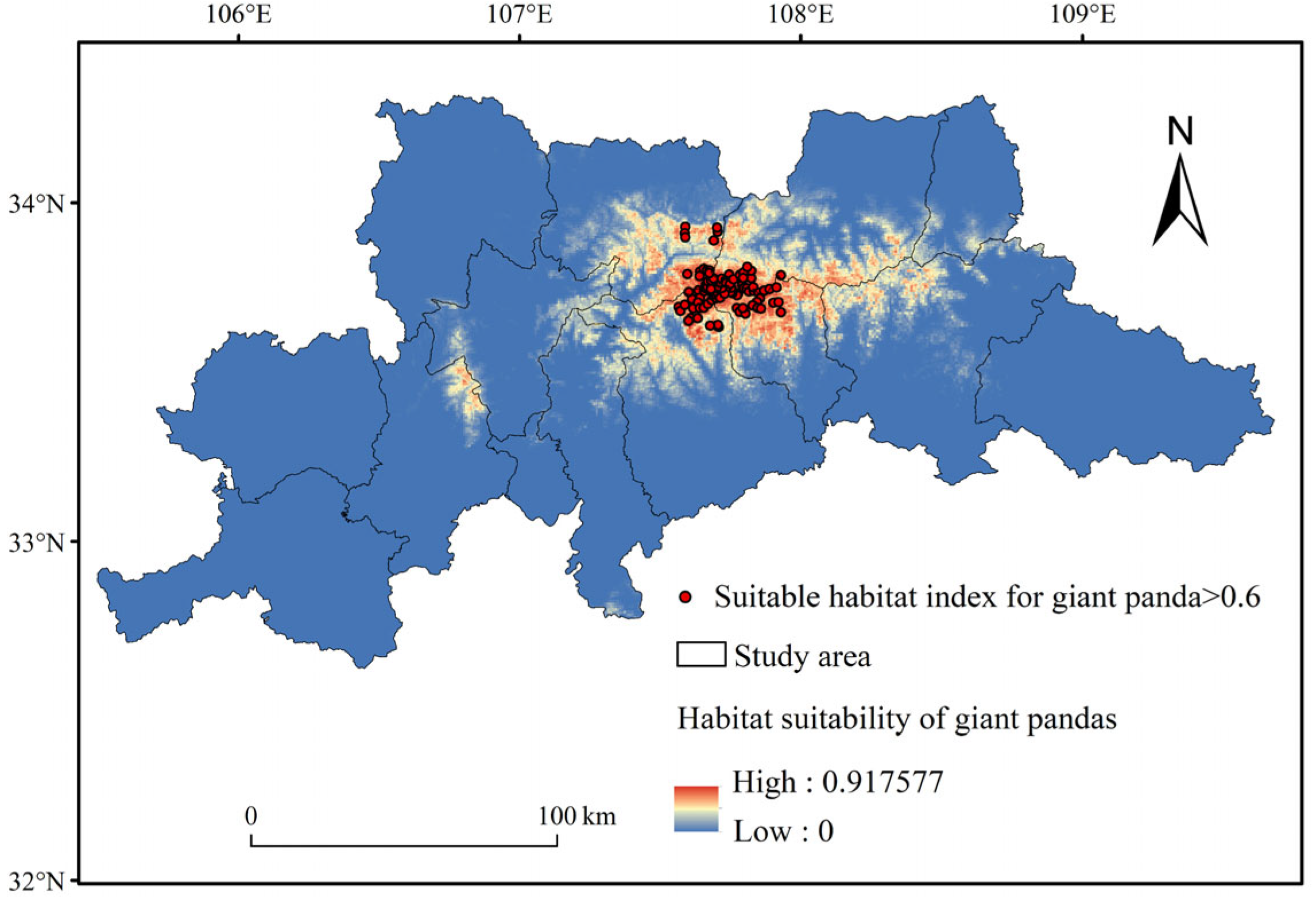
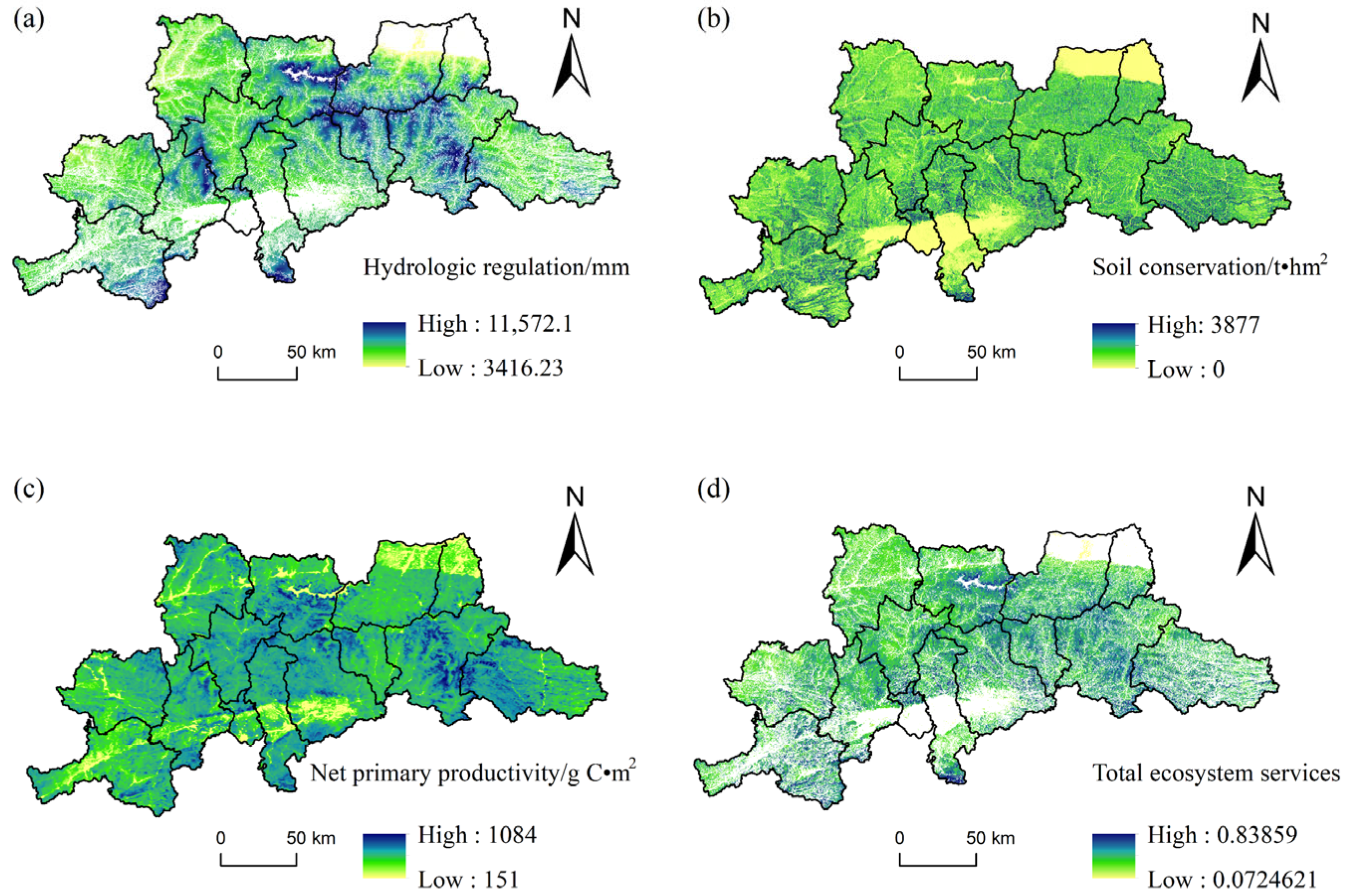

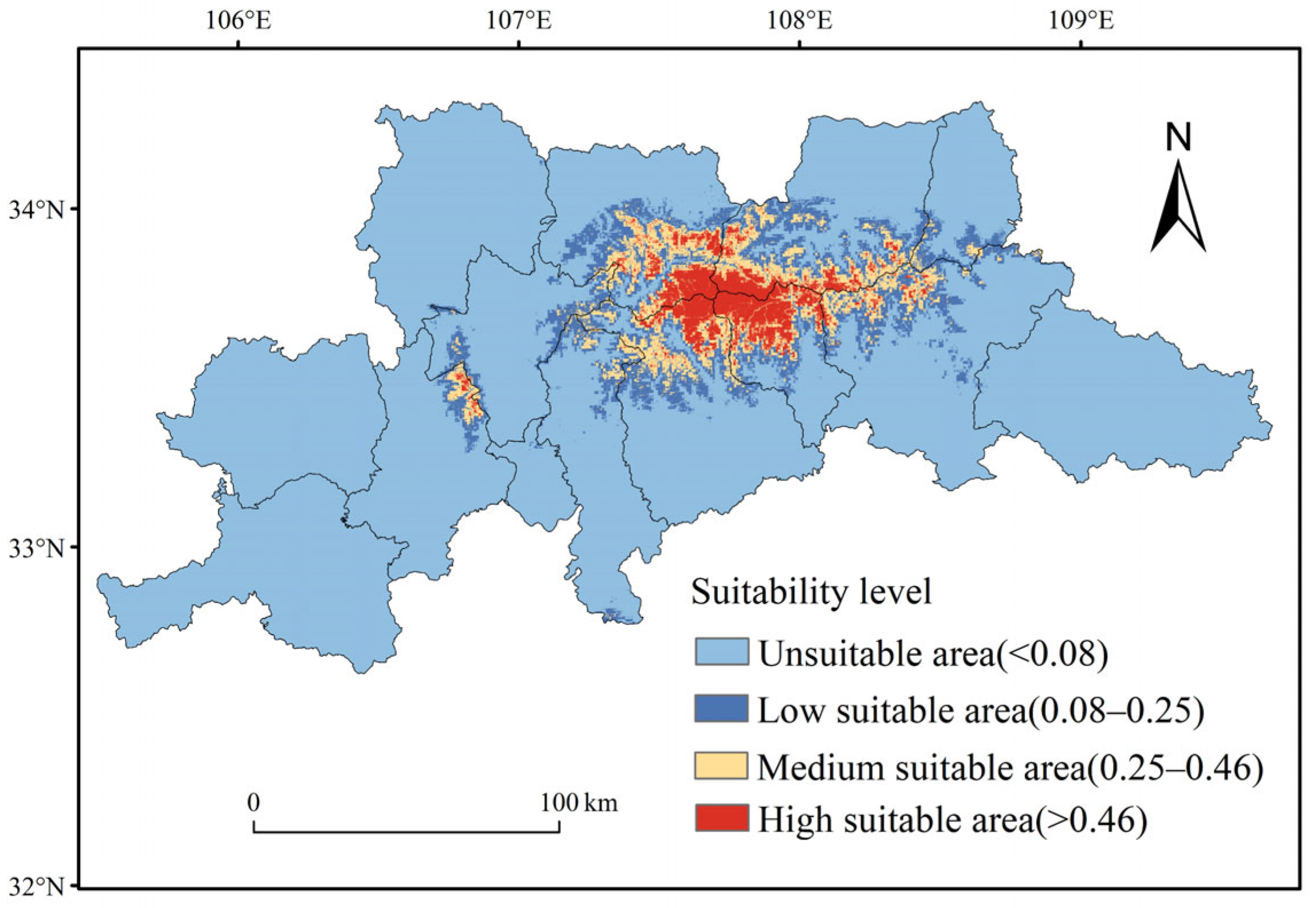
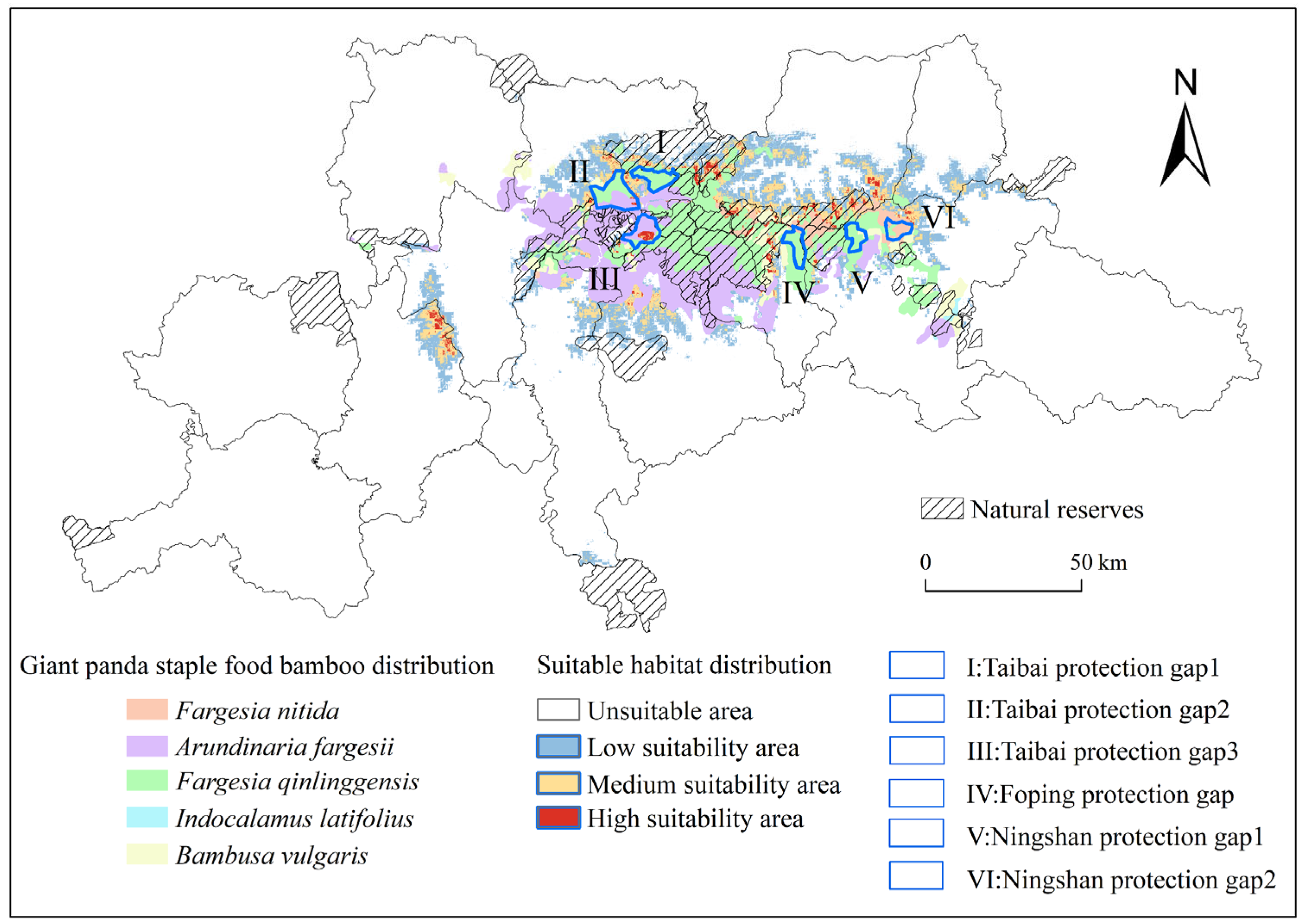
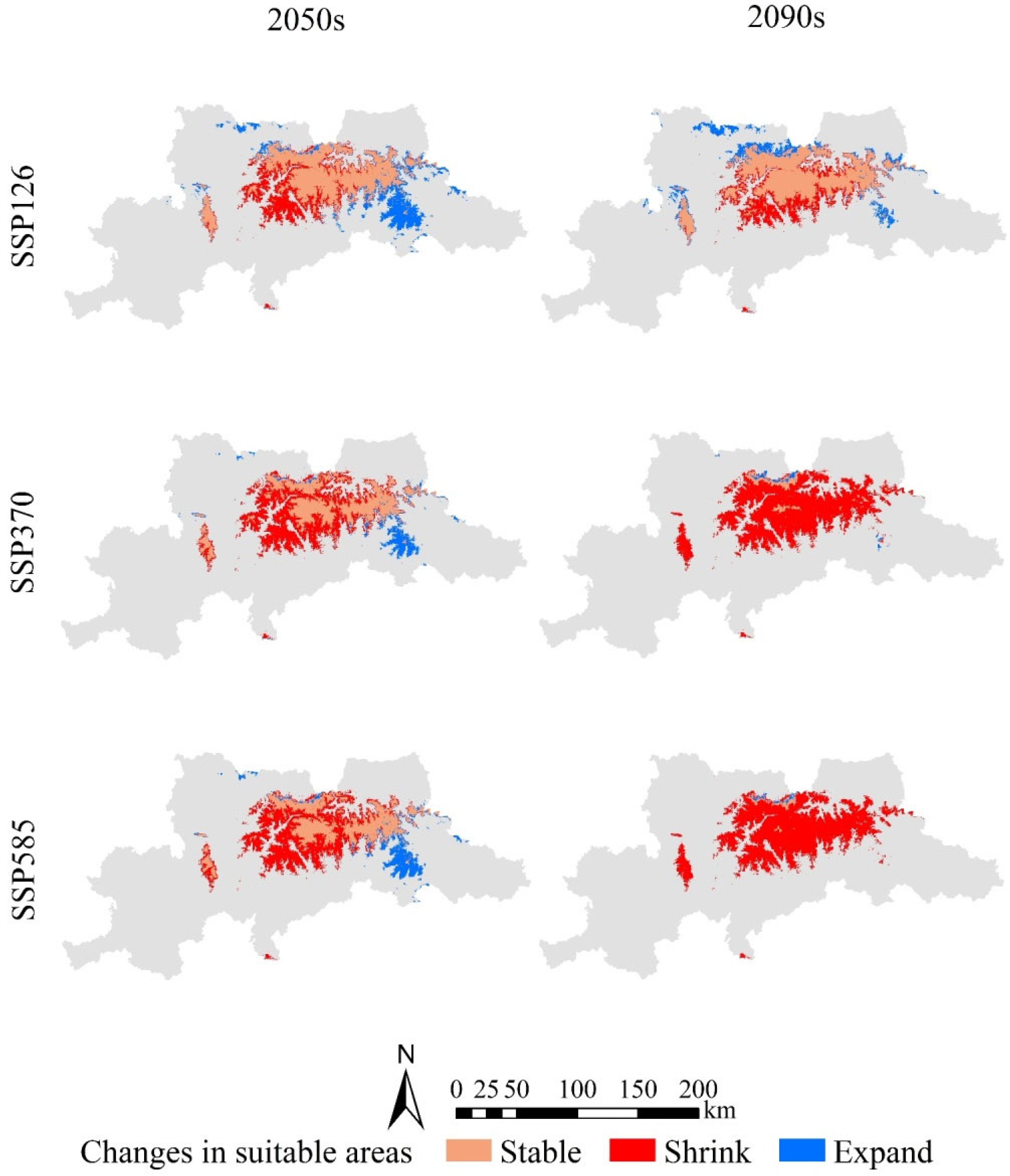
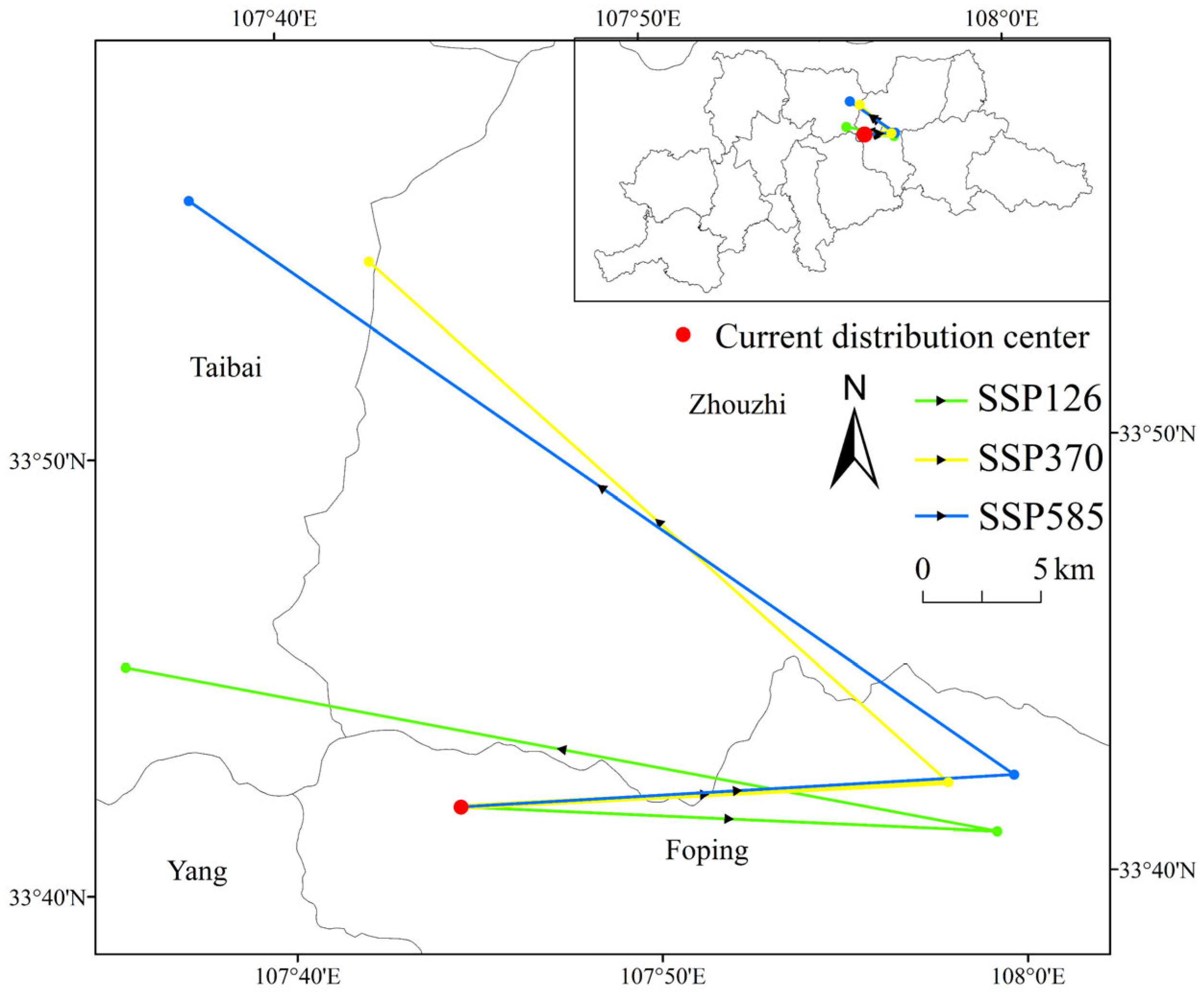
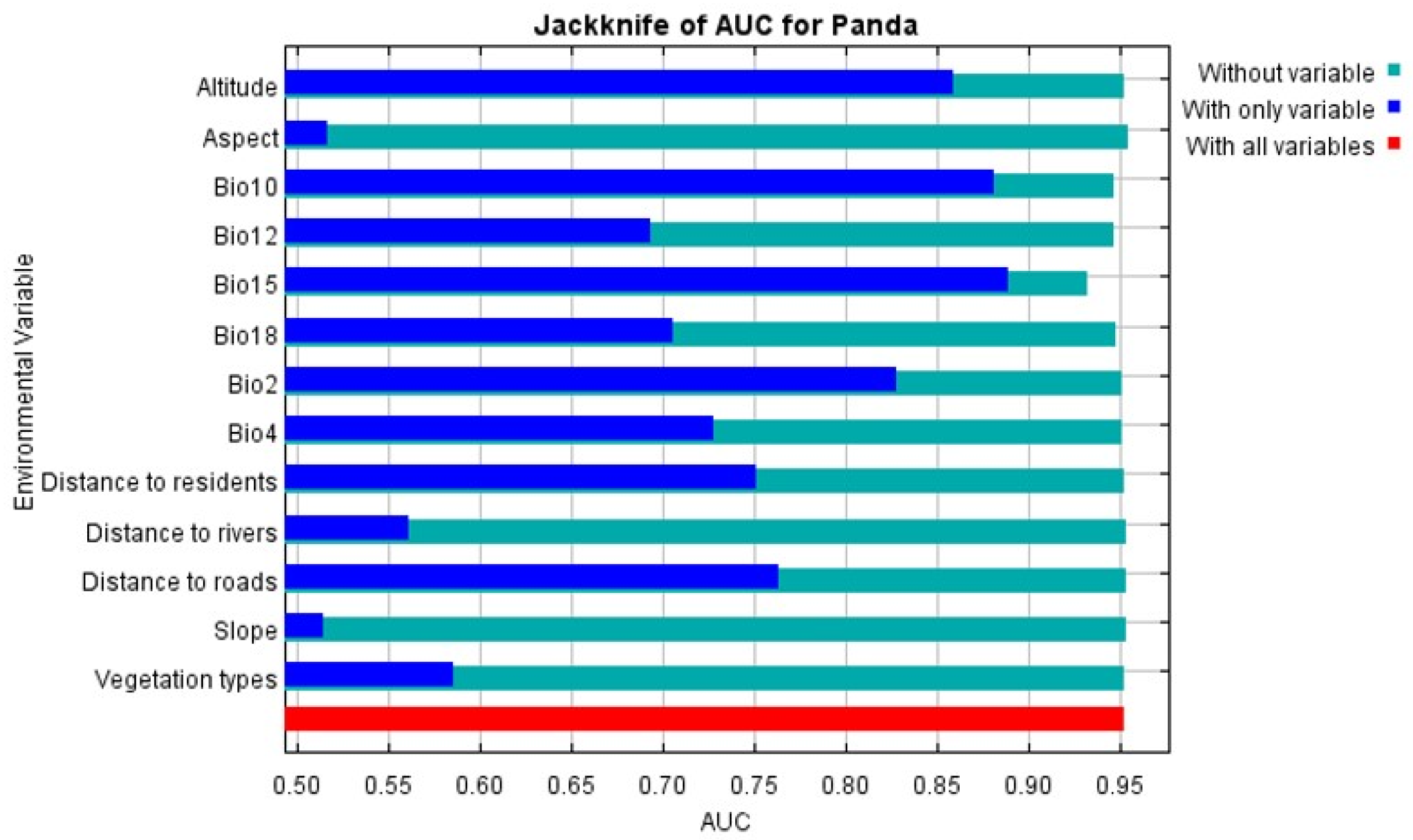
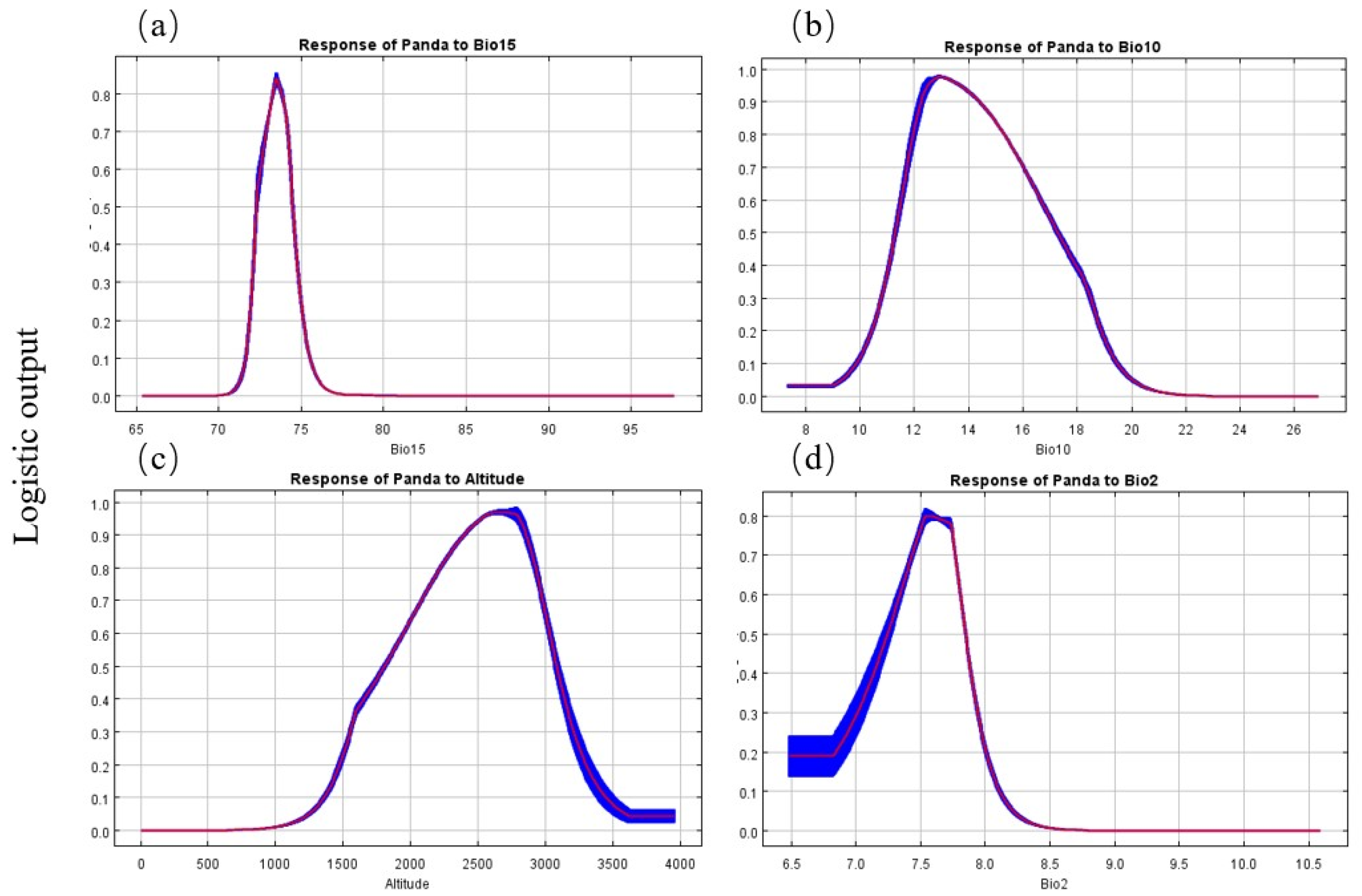
| Name | Accuracy | Time | Source |
|---|---|---|---|
| National average annual rainfall erosivity | 90 m | 1980–2010 | National Earth System Science Data Center |
| Chinese soil dataset | 1: 1 million | Second soil census | Big Data Center Of Sciences In Arid Regions |
| National DEM (SRTM) | 90 m | 2000 | Computer Network Information Center, Chinese Academy of Sciences |
| National land cover | 90 m | 2000, 2010 | Institute of Remote Sensing, Chinese Academy of Sciences |
| National vegetation coverage | 250 m | Every ten days in 2000 and 2010 | Institute of Remote Sensing and Digital Earth, Chinese Academy of Sciences |
| National monthly precipitation map | 90 m | Fifty years of average monthly rainfall | Chinese Ecosystem Research Network |
| Precipitation runoff relationship | National Ecosystem Survey and Assessment of China (2000–2010) | ||
| Runoff producing precipitation | National Ecosystem Survey and Assessment of China (2000–2010) | ||
| Efficiency coefficient of ecosystem hydrological regulation | National Ecosystem Survey and Assessment of China (2000–2010) | ||
| Net primary productivity | 250 m | 2000–2010 | National Ecosystem Survey and Assessment of China (2000–2010) |
| Climate Change Scenarios | Years | AUC Value |
|---|---|---|
| Low force scenario SSP126 | 2041–2060 | 0.962 |
| 2081–2100 | 0.958 | |
| Moderate to high force scenarios SSP370 | 2041–2060 | 0.959 |
| 2081–2100 | 0.960 | |
| High force scenario SSP585 | 2041–2060 | 0.958 |
| 2081–2100 | 0.959 |
| Suitable Zone | Comparative Indicators | Current | SSP126 | SSP370 | SSP585 | |||
|---|---|---|---|---|---|---|---|---|
| 2041–2060 | 2081–2100 | 2041–2060 | 2081–2100 | 2041–2060 | 2081–2100 | |||
| Area/km2 | 1153.75 | 139.81 | 289.15 | 35.25 | 6.49 | 45.75 | 7.52 | |
| High suitability area | Change area | −1013.94 | −864.6 | −1118.5 | −1147.26 | −1108 | −1146.23 | |
| Proportion % | 3.31 | 0.4 | 0.83 | 0.1 | 0.02 | 0.13 | 0.02 | |
| Area/km2 | 1878.64 | 759.85 | 675.67 | 437.12 | 24.36 | 318.79 | 21.18 | |
| Medium suitability area | Change area | −1118.79 | −1202.97 | −1441.52 | −1854.28 | −1559.85 | −1857.46 | |
| Proportion % | 5.38 | 2.18 | 1.93 | 1.25 | 0.07 | 0.91 | 0.06 | |
| Area/km2 | 2843.03 | 2165.28 | 1507.9 | 1913.95 | 148.13 | 1726.73 | 59.75 | |
| Low suitability area | Change area | −677.75 | −1335.13 | −929.08 | −2694.9 | −1116.3 | −2783.28 | |
| Proportion % | 8.14 | 6.2 | 4.32 | 5.48 | 0.42 | 4.95 | 0.17 | |
| Area/km2 | 29,042.8 | 31,853.27 | 32,445.47 | 32,531.89 | 34,739.23 | 32,826.92 | 34,829.77 | |
| Unsuitable area | Change area | 2810.47 | 3402.67 | 3489.09 | 5696.43 | 3784.12 | 5786.97 | |
| Proportion % | 83.17 | 91.22 | 92.92 | 93.17 | 99.49 | 94.01 | 99.75 | |
| Area/km2 | 5875.42 | 3064.94 | 2472.72 | 2386.32 | 178.98 | 2091.27 | 88.45 | |
| Total suitable area | Change area | −2810.48 | −3402.70 | −3489.1 | −5696.44 | −3784.15 | −5786.97 | |
| Proportion % | 16.83 | 8.78 | 7.08 | 6.83 | 0.51 | 5.99 | 0.25 | |
| Environmental Variable | Percent Contribution | Permutation Importance |
|---|---|---|
| Bio10 Mean temperature of warmest quarter (°C) | 46.7 | 23.1 |
| Bio15 (precipitation seasonality) | 21.4 | 15.6 |
| Bio12 (annual precipitation (mm)) | 17 | 34.9 |
| Bio2 (mean diurnal range (°C)) | 2.9 | 1.4 |
| Distance to roads | 2.7 | 0.4 |
| Bio4 (temperature seasonality (°C)) | 2.5 | 0.8 |
| Bio18 Precipitation of warmest quarter (mm) | 1.3 | 22.2 |
| Distance to residents | 1.3 | 0.2 |
| Altitude (m) | 1.2 | 0.6 |
| Vegetation types | 1.1 | 0.1 |
| Slope | 0.7 | 0.4 |
| Aspect | 0.6 | 0.2 |
| Distance to rivers | 0.4 | 0.2 |
Disclaimer/Publisher’s Note: The statements, opinions and data contained in all publications are solely those of the individual author(s) and contributor(s) and not of MDPI and/or the editor(s). MDPI and/or the editor(s) disclaim responsibility for any injury to people or property resulting from any ideas, methods, instructions or products referred to in the content. |
© 2024 by the authors. Licensee MDPI, Basel, Switzerland. This article is an open access article distributed under the terms and conditions of the Creative Commons Attribution (CC BY) license (https://creativecommons.org/licenses/by/4.0/).
Share and Cite
Ma, Q.; Zhang, H.; Liu, J.; Guo, Y.; Liu, K. Habitat Suitability Analysis and Future Distribution Prediction of Giant Panda (Ailuropoda melanoleuca) in the Qinling Mountains, China. Diversity 2024, 16, 412. https://doi.org/10.3390/d16070412
Ma Q, Zhang H, Liu J, Guo Y, Liu K. Habitat Suitability Analysis and Future Distribution Prediction of Giant Panda (Ailuropoda melanoleuca) in the Qinling Mountains, China. Diversity. 2024; 16(7):412. https://doi.org/10.3390/d16070412
Chicago/Turabian StyleMa, Qi, Huihui Zhang, Jiechao Liu, Yiman Guo, and Kang Liu. 2024. "Habitat Suitability Analysis and Future Distribution Prediction of Giant Panda (Ailuropoda melanoleuca) in the Qinling Mountains, China" Diversity 16, no. 7: 412. https://doi.org/10.3390/d16070412






